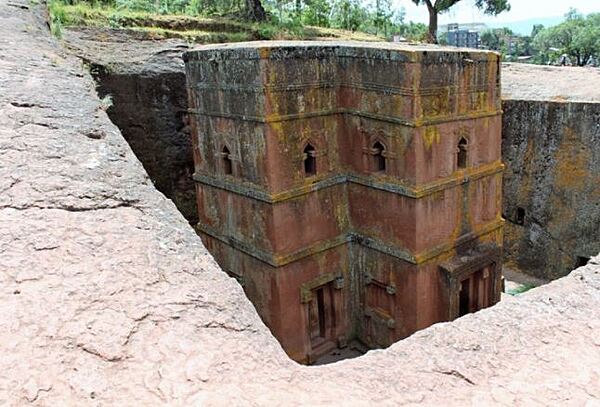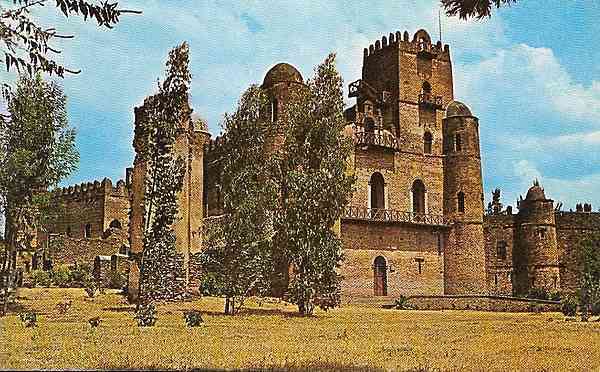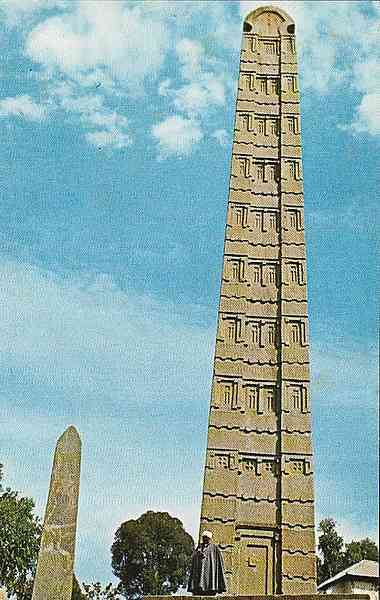
conventional long form: Federal Democratic Republic of Ethiopia
conventional short form: Ethiopia
local long form: YeItyop'iya Federalawi Demokrasiyawi Ripeblik
local short form: Ityop'iya
former: Abyssinia, Italian East Africa
abbreviation: FDRE
etymology: the country name derives from the Greek word "Aethiopia," which in classical times referred to lands south of Egypt in the Upper Nile region
federal parliamentary republic
name: Addis Ababa
geographic coordinates: 9 02 N, 38 42 E
time difference: UTC+3 (8 hours ahead of Washington, DC, during Standard Time)
etymology: the name in Amharic means "new flower" and was bestowed on the city in 1889, three years after its founding
12 ethnically based regional states (kililoch, singular - kilil) and 2 chartered cities* (astedader akabibiwach, singular - astedader akabibi); Adis Abeba* (Addis Ababa), Afar, Amara (Amhara), Binshangul Gumuz, Dire Dawa*, Gambela Hizboch (Gambela), Hareri Hizb (Harari), Oromia, Sidama, Sumale, Tigray, YeDebub Biheroch Bihereseboch na Hizboch (Southern Nations, Nationalities and Peoples), YeDebub M'irab Ityop'iya Hizboch (Southwest Ethiopia Peoples), Southern Ethiopia Peoples
oldest independent country in Africa and one of the oldest in the world - at least 2,000 years (may be traced to the Aksumite Kingdom, which coalesced in the first century B.C.)
Derg Downfall Day (defeat of MENGISTU regime), 28 May (1991)
history: several previous; latest drafted June 1994, adopted 8 December 1994, entered into force 21 August 1995
amendments: proposals submitted for discussion require two-thirds majority approval in either house of Parliament or majority approval of one-third of the State Councils; passage of amendments other than constitutional articles on fundamental rights and freedoms and the initiation and amendment of the constitution requires two-thirds majority vote in a joint session of Parliament and majority vote by two thirds of the State Councils; passage of amendments affecting rights and freedoms and amendment procedures requires two-thirds majority vote in each house of Parliament and majority vote by all the State Councils
civil law system
has not submitted an ICJ jurisdiction declaration; non-party state to the ICCt
citizenship by birth: no
citizenship by descent only: at least one parent must be a citizen of Ethiopia
dual citizenship recognized: no
residency requirement for naturalization: 4 years
18 years of age; universal
chief of state: President SAHLE-WORK Zewde (since 25 October 2018)
head of government: Prime Minister ABIY Ahmed Ali (since April 2018); Deputy Prime Minister and Minister of Foreign Affairs DEMEKE Mekonnen Hassen (since 29 November 2012)
cabinet: Council of Ministers selected by the prime minister and approved by the House of People's Representatives
elections/appointments: president indirectly elected by both chambers of Parliament for a 6-year term (eligible for a second term); election held on 21 June 2021 and 30 September 2021 (the scheduled 29 August 2020 election was postponed by Prime Minister ABIY due to the COVID-19 pandemic); prime minister designated by the majority party following legislative elections
election results:
2021: SAHLE-WORK Zewde reelected president during joint session of Parliament, vote - 659 (unanimous); ABIY confirmed Prime Minister by House of Peoples' Representatives (4 October 2021)
2018: SAHLE-WORK Zewde elected president during joint session of Parliament, vote - 659 (unanimous); note - snap election held on 25 October 2018 due to resignation of President MULATA Teshome
note: SAHLE-WORK Zewde is the first female elected head of state in Ethiopia; she is currently the only female president in Africa.
description: bicameral Parliament consists of:
House of Federation or Yefedereshein Mikir Bete (153 seats maximum; 144 seats current; members indirectly elected by state assemblies to serve 5-year terms)
House of People's Representatives or Yehizb Tewokayoch Mekir Bete (547 seats maximum; 470 seats current; members directly elected in single-seat constituencies by simple majority vote; 22 seats reserved for minorities; all members serve 5-year terms)
elections: House of Federation - last held 4 October 2021 (next expected in October 2026)
House of People's Representatives - last held in two parts on 21 June 2021 and 30 September 2021 (next expected in June 2026)
election results: House of Federation - percent of vote by coalition/party - NA; seats by coalition/party - NA; composition - men 100, women 44, percent of women 30.6%
House of Representatives - percent of vote by coalition/party - NA; seats by coalition/party - Prosperity Party 454, NAMA 5, EZEMA 4, Gedeo People's Democratic organization 2, Kucha People Democratic Party 1, independent 4; composition - men 275, women 195, percent of women 41.5%; note - total Parliament percent of women 38.9%
notes: House of Federation is responsible for interpreting the constitution and federal-regional issues and the House of People's Representatives is responsible for passing legislation; percent of vote percentages are calculated on the number of members actually seated versus on the constitutional maximums
highest court(s): Federal Supreme Court (consists of 11 judges); note - the House of Federation has jurisdiction for all constitutional issues
judge selection and term of office: president and vice president of Federal Supreme Court recommended by the prime minister and appointed by the House of People's Representatives; other Supreme Court judges nominated by the Federal Judicial Administrative Council (a 10-member body chaired by the president of the Federal Supreme Court) and appointed by the House of People's Representatives; judges serve until retirement at age 60
subordinate courts: federal high courts and federal courts of first instance; state court systems (mirror structure of federal system); sharia courts and customary and traditional courts
House of People's Representatives:
Ethiopian Citizens for Social Justice and Democracy or EZEMA [BERHANU Nega]
Gedeo People's Democratic Party
Independent [n/a]
Kucha People Democratic Party
National Movement of Amhara or NAMA [BELETE Molla]
Prosperity Party or PP [ABIY Ahmed Ali]
note: Ethiopia has over fifty national-level and regional-level political parties. The ruling party, the Prosperity Party, was created by Prime Minister ABIY in November 2019 from member parties of the former Ethiopian People’s Revolutionary Democratic Front (EPRDF), which included the Amhara Democratic Party (ADP), Oromo Democratic Party (ODP), Southern Ethiopian People's Democratic Movement (SEPDM), plus other EPRDF-allied parties such as the Afar National Democratic Party (ANDP), Benishangul Gumuz People’s Democratic Party (BGPDP), Gambella People’s Democratic Movement (GPDM), Somali People’s Democratic Party (SPDP), and the Harari National League (HNL). Once the Prosperity Party was created, the various ethnically-based parties that comprised or were affiliated with the EPRDF were subsequently disbanded; in January 2021, the Ethiopian electoral board de-registered the Tigray People’s Liberation Front or TPLF; national level parties are qualified to register candidates in multiple regions across Ethiopia; regional parties can register candidates for both national and regional parliaments, but only in one region of Ethiopia
ACP, AfDB, ATMIS, AU, BRICS, COMESA, EITI, FAO, G-24, G-77, IAEA, IBRD, ICAO, ICRM, IDA, IFAD, IFC, IFRCS, IGAD, ILO, IMF, IMO, Interpol, IOC, IOM, IPU, ISO, ITSO, ITU, ITUC (NGOs), MIGA, NAM, OPCW, PCA, UN, UNCTAD, UNESCO, UNHCR, UNIDO, UNMISS, UNOOSA, UNWTO, UPU, WCO, WFTU (NGOs), WHO, WIPO, WMO, WTO (accession candidate)
chief of mission: Ambassador SELESHI Bekele Awulachew (since 7 June 2022)
chancery: 3506 International Drive NW, Washington, DC 20008
telephone: [1] (202) 364-1200
FAX: [1] (202) 587-0195
email address and website:
ethiopia@ethiopianembassy.org
https://ethiopianembassy.org/
consulate(s) general: Los Angeles
consulate(s): New York
chief of mission: Ambassador Ervin MASSINGA (since 4 October 2023)
embassy: Entoto Street, P.O. Box 1014, Addis Ababa
mailing address: 2030 Addis Ababa Place, Washington DC 20521-2030
telephone: [251] 111-30-60-00
FAX: [251] 111-24-24-01
email address and website:
AddisACS@state.gov
https://et.usembassy.gov/
three equal horizontal bands of green (top), yellow, and red, with a yellow pentagram and single yellow rays emanating from the angles between the points on a light blue disk centered on the three bands; green represents hope and the fertility of the land, yellow symbolizes justice and harmony, while red stands for sacrifice and heroism in the defense of the land; the blue of the disk symbolizes peace and the pentagram represents the unity and equality of the nationalities and peoples of Ethiopia
note: Ethiopia is the oldest independent country in Africa, and the three main colors of her flag (adopted ca. 1895) were so often appropriated by other African countries upon independence that they became known as the Pan-African colors; the emblem in the center of the current flag was added in 1996
Abyssinian lion (traditional), yellow pentagram with five rays of light on a blue field (promoted by current government); national colors: green, yellow, red
name: "Whedefit Gesgeshi Woud Enat Ethiopia" (March Forward, Dear Mother Ethiopia)
lyrics/music: DEREJE Melaku Mengesha/SOLOMON Lulu
note: adopted 1992
total World Heritage Sites: 11 (9 cultural, 2 natural)
selected World Heritage Site locales: (c); Simien National Park (n);
(c); Simien National Park (n);  (c);
(c);  (c); Lower Valley of the Awash (c); Lower Valley of the Omo (c); Tiya (c); Harar Jugol, the Fortified Historic Town (c); Konso Cultural Landscape (c); Gedeo Cultural Landscape (c)
(c); Lower Valley of the Awash (c); Lower Valley of the Omo (c); Tiya (c); Harar Jugol, the Fortified Historic Town (c); Konso Cultural Landscape (c); Gedeo Cultural Landscape (c)
NOTE: The information regarding Ethiopia on this page is re-published from the 2024 World Fact Book of the United States Central Intelligence Agency and other sources. No claims are made regarding the accuracy of Ethiopia 2024 information contained here. All suggestions for corrections of any errors about Ethiopia 2024 should be addressed to the CIA or the source cited on each page.
This page was last modified 04 May 24, Copyright © 2024 ITA all rights reserved.